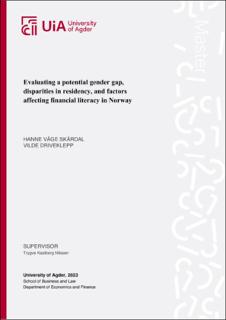| dc.description.abstract | This paper analyses a questionnaire measuring the financial literacy of the Norwegian respondents. There is a consistent gender gap in investments, and as this paper concluded, in financial literacy as well. Variables such as education, income, gender, and risk aversion have significant impact on financial literacy. There are some significant impacts of where the respondent’s resident, whether it is a central area, a specific county, or municipalities containing a large proportion of investors. The survey revealed how females are more risk averse, but also more affected by other factors such as environment and upbringing than males. Another interesting result is the distinctive difference in what the respondents consider a relevant investment product, and what they currently possess. Our recommendation to reduce the gender gap in financial literacy is by incorporate and evolve the school’s curriculum within personal finance as well as encourage openness about the subject. | |
